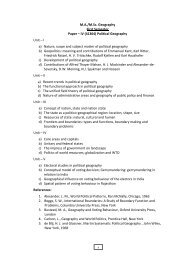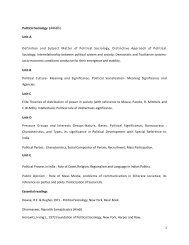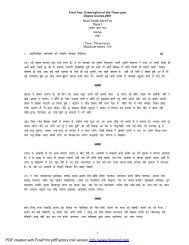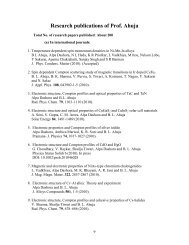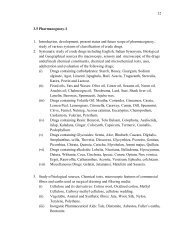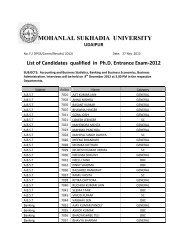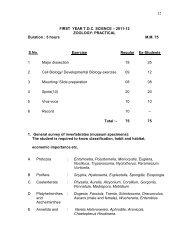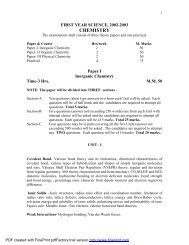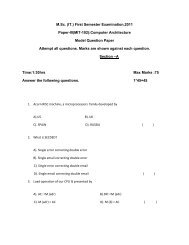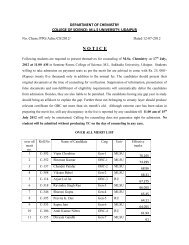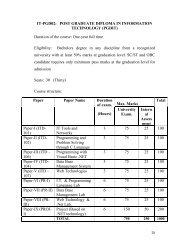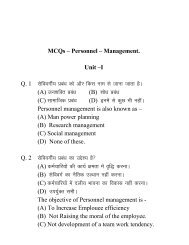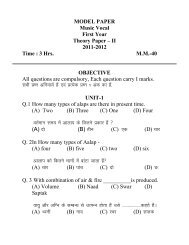BSC Botany First Year :ALGAE, LICHENS AND BRYOPHYTES
BSC Botany First Year :ALGAE, LICHENS AND BRYOPHYTES
BSC Botany First Year :ALGAE, LICHENS AND BRYOPHYTES
You also want an ePaper? Increase the reach of your titles
YUMPU automatically turns print PDFs into web optimized ePapers that Google loves.
FIRST YEAR SCIENCE, 2010-2011<br />
BOTANY<br />
Papers No. of<br />
Papers<br />
Paper I<br />
Paper II<br />
Paper III<br />
PRACTICALS<br />
Algae, Lichens and<br />
Bryophytes<br />
Mycology, Microbiology and<br />
Plant Pathology<br />
Palaeobotany, Pteridophytes &<br />
Gymnosperms.<br />
1<br />
No. of<br />
Periods<br />
per week<br />
Duration of examination of each theory paper 3 hrs.<br />
Duration of examination of practical 5 hrs.<br />
(in one day)<br />
1<br />
1<br />
1<br />
2<br />
2<br />
2<br />
4<br />
Max-<br />
imum<br />
Marks<br />
50<br />
50<br />
50<br />
75<br />
12<br />
Min.<br />
pass<br />
marks<br />
54<br />
27<br />
Credit<br />
Hours<br />
50<br />
50<br />
50<br />
50
FIRST YEAR SCIENCE, 2010-2011<br />
BOTANY<br />
PAPER I<br />
<strong>ALGAE</strong>, <strong>LICHENS</strong> <strong>AND</strong> <strong>BRYOPHYTES</strong><br />
Unit-1 General characters, thallus organisation, pigments and reserve food<br />
material in algae. Electron microscopic structure of Chalamydomonas and<br />
the Cyanophycean cell. Fritsch's Classification and modern trends in<br />
classification. Morphology, reproduction and evolutionary relationships in<br />
the following : Cyanophyta: Oscillatoria, Nostoc. Chlorophyta:<br />
Chlamydomonas, Volvox, Hydrodictyon and Cladophora.<br />
-10 hours<br />
Unit-2 General characters of Xanthophyta, its relationship with Chlorophyta,<br />
Morphology and reproduction in Xanthophyta : Vaucheria; Chlorophyta :<br />
Coleochaete and Oedogonium; Charophyta : Chara. General account of<br />
Bacillariophyceae.<br />
-10 hours<br />
Unit-3 Morphology and reproduction in Phaeophyta: Ectocarpus ; Rhodophyta:<br />
Polysiphonia. Economic importance of algae. Lichens: Important features,<br />
structure, habitat, importance as colonisers and indicators of environment.<br />
Vegetative multiplication and life cycle of Parmelia and Usnea.<br />
-10 hours<br />
Unit-4 General characters and classification of Bryophytes. The evolutionary<br />
trends in thallus structure and sporogonium. Morphology and life history<br />
of Riccia, Marchantia, Pellia, Porella and Anthoceros.<br />
-10 hours<br />
Unit-5 Morphology, life history and relationships of Sphagnum and Polytrichum.<br />
Economic and Biological importance of Bryophytes.<br />
-10 hours<br />
Note:<br />
The paper setter is required to set questions of 3 types contained in 3 Sections (Section<br />
A- 10 questions, Section B- 10 questions and Section C- 4 questions) from the 5 units of<br />
each paper. There will be 10 questions in Section A which will be asked from all the 5<br />
units, i.e., 2 questions from each unit. These questions have to be answered in one word<br />
or a few words only. Each question will be of half mark. All the questions in Section A<br />
are compulsory. In Section B, 10 questions will be set from the 5 units, i.e., 2 questions<br />
from each unit. Students are required to attempt at least 1 question from each unit. Each<br />
13
question will carry 5 marks. The answers of each question should be given in about 250<br />
words. In Section C there will be 4 descriptive type questions set from all the 5 units, not<br />
more than 1 question from each unit. These questions may also have sub-divisions. The<br />
students are required to answer 2 questions, each in approximately 500 words. Each<br />
question will carry 10 marks.<br />
In short, pattern of question paper and distribution of marks for UG classes will<br />
be as under:<br />
Section A: 10 questions, 2 questions from each unit, short answer, all questions<br />
compulsory. Total marks : 05<br />
Section B: 10 questions, 2 question from each unit, 5 question to be attempted, at<br />
least 1 from each unit, answer approximately in 250 words. Total marks : 25<br />
Section C: 04 questions (question may have sub-division), not more than 1 question<br />
from each unit, descriptive type, answer in about 500 words, 2 questions to be<br />
attempted. Total marks : 20<br />
14



